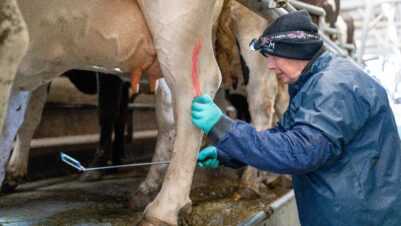Infectious diseases pose a significant threat to the dairy industry, impacting animal health and welfare, productivity and farm profitability. In this article, we discuss how effective management requires a holistic approach, combining closer vet/farmer collaboration with the use of the latest smart technologies.
Current on-farm infectious disease management
Currently, infectious disease management on farms can best be described as a mixed bag. There has been little change in the rates of mastitis and lameness, and even with infectious endemic diseases, we are still looking at low vaccine penetration rates: the best being for bovine viral diarrhoea (BVD) at 45 percent (NOAH, 2022). If an infectious disease is endemic we often don’t see the bigger red flag clinical signs. However, there are multiple other smaller implications, such as cows taking a few days longer to get in calf or producing 1 to 2 litres less milk per day. This may not be a problem for the odd cow, but multiple cows over a whole herd can result in significant losses and inefficiencies.
It’s in situations like this where having the right data comes in. We’re in a position now where we have an almost overwhelming amount of data coming out of farms, and we don’t always even know where to begin using and analysing that data. But with smart technology like the VetIMPRESS platform, you can pull data in and standardise it from multiple sources for individual animals, as well as the herd. For example, analysing anti-inflammatory use, youngstock vaccination spend and fertility treatment spend is easy, and the data can all be exported out into other programs for further analysis and benchmarking.
The importance of collaboration
If we want to get the full picture about what’s happening on-farm, it’s not just about the vet and farmer talking to each other – everyone needs to be sharing
Sharing data enables closer collaboration, something which is critical for effective infectious disease management. Whether it’s vets sharing their expertise on infectious disease, when to employ strategies like vaccination and biosecurity, or farmers sharing their disease management best practices with each other, a collaborative approach is positive for the industry. There’s also scope for collaboration that goes beyond the vet/farmer relationship. If we want to get the full picture about what’s happening on-farm, it’s not just about the vet and farmer talking to each other – everyone needs to be sharing. The data coming from milking robots and wearable technology on cows, the data collected from nutritionists and foot trimmers is all a piece of the puzzle that adds up to what we know about an animal. Collaboration is key to how we move the dairy industry forward.
The role of smart technology in mastitis management
Smart technology, such as cow management apps and on-farm diagnostic solutions, is playing an increasingly important role in the early detection and management of infectious diseases, enabling a more targeted and efficient approach.
Milder cases that do not receive antibiotic or anti-inflammatory treatment are rarely noted down, meaning the true picture of mastitis prevalence on-farm is often not fully understood
One of the biggest benefits of smart technology is that it provides an easier way to instantly input data cow-side, removing the risk of it being forgotten. This helps to increase the overall amount of accurate data that’s available, providing a true picture of what is happening on-farm. This is especially helpful for mastitis where clinical data tends not to be well recorded. Milder cases that do not receive antibiotic or anti-inflammatory treatment are rarely noted down, meaning the true picture of mastitis prevalence on-farm is often not fully understood. Being able to instantly record clinical data and observations about an individual animal, against their unique ID, on your phone or tablet could be game-changing (Figure 1).

On-farm diagnostic solutions are becoming increasingly available, enabling farmers and vets to tell which pathogens are affecting their animals. For mild and moderate cases of mastitis, they provide an opportunity for vets and farmers to strategically test and treat clinical mastitis, rather than immediately treating with antibiotics. Research has shown that in those mild to moderate cases, postponing treatment with antibiotics for 24 hours does not impact on the clinical outcome, as long as cows are stripped out, eating and drinking, and given pain relief (de Jong et al., 2023).
While sampling can be helpful, in some cases immediate treatment is appropriate. The author advocates for looking at the bigger farm picture and the cow, as well as the sample (Figure 2). This is where having that data comes in; at a farm level, this means the herd history including previous mastitis patterns and pathogens. Then it’s about looking at the cow in front of you, and reviewing the body condition score, mobility scores, any concurrent disease, stage of lactation and previous mastitis history. All of that data and the diagnostics is going to help you make an informed decision about the most appropriate treatment for that cow.

Sustainable antimicrobial usage
Responsible and sustainable antimicrobial usage (AMU) is a hot topic in the dairy industry, and it’s something that’s made possible by having the data that enables targeted treatment of infectious diseases. Dairy farmer Dan Avery, of Stydd Hall Farm in Ashbourne, Derbyshire, has experienced the benefits of accessing data on the VetIMPRESS platform. “I have access to medicine and treatment records for individual cows and so does my vet. Access to this data allows us to make informed and effective treatment and management decisions, including using antibiotics appropriately. This ensures we comply with legislation for Red Tractor audits,” says Dan. For veterinary professionals, having access to accurate data enables a seamless approach to animal care. Having the right data available at the right time allows the vet and the farmer to make informed decisions about anything and everything. Practices can use tools such as VetIMPRESS to standardise and streamline the services offered to their farmers, such as vet tech and foot trimming services – recording scores and treatments against individual animals, and enabling multiple people to visualise and analyse that data.
Towards a more sustainable future for dairy farming
At the Jump to the Future: Dairy Farming 2050 event last summer, collaboration, data and technology were very much on the agenda when expert speakers discussed the current and future challenges and opportunities in the industry. A message that came through strongly was to embrace change or be left behind. If you look at the bigger picture, people want food security and more transparency in the food chain, and in order to do that, we need data and we need to be working collaboratively. Vets are encouraged to be open-minded and embrace technology and data, and think about what they’re trying to achieve. Smart technology and data can help you run a more sustainable business.
It can also play a part in making the wider dairy industry more sustainable. Good data will support you to control endemic diseases in cows, control mastitis and get a handle on lameness. Overall, you’re going to have longer surviving, more productive animals and that is what will ultimately make the industry more sustainable.








